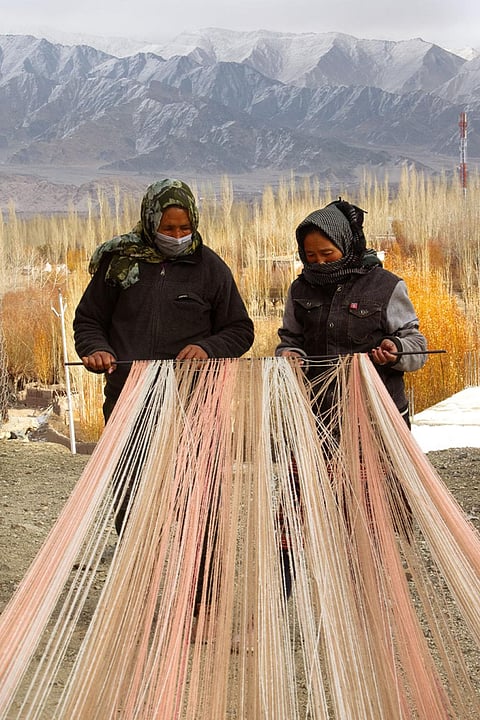Women’s Day 2024: Ladakh’s looms of life
Located 4,900 metres above sea level on the Indo-China border, Chumur village’s remoteness dictates the way people craft their lives and livelihoods. Here, in the heart of Ladakh’s Changthang region, the Changpa people, pastoralist nomads, navigate their existence around their prized assets: goats, yaks and sheep. The harsh climate—over six months of extreme cold and a short-lived summer—sets the way for them to manage their economy. While men tend to the rearing and shearing of livestock during the brief summer, women spend the long winter months weaving and knitting wool into various garments and goods, either for personal use or for the local market.
Not known to many, Chumur and other villages in the high-altitude pasturelands of Changthang are hubs of a lucrative fibre trade. At the core of this trade lies the indigenous Changra goat, used for producing one of the world’s most sought-after natural wool—GI Ladakh pashmina or cashmere. It is said that to own this precious fibre, Dogra kings annexed this region to their kingdom in the 19th century. India produces less than 1 per cent of the global value of 10,000-15,000 tonnes of pashmina per year, but it is considered the finest in quality. Changpa women, thus, are at the centre of this trade. The famed pashmina shawl fetches up to Rs 50,000 apiece in upmarket showrooms in Delhi or Mumbai. Yet the local rearers earn meagre wages because they only collect and send the raw wool to processors in Jammu and Kashmir, Punjab and Himachal Pradesh. “Earlier, I would earn just Rs 1,000 during the tourist season because our community did not know the true value of the product or had the know-how to market it,” says Shakeela Bano, a 47-year-old resident of Leh.
This changed in 2016 with the start of a skill development project for women. The transformation started during a visit to Chumur by Prasanna Ramaswamy, the deputy collector of Leh at the time. He was struck by the low price of locally crafted goods. In response, he initiated the Laksal skill-development programme to enhance the craftsmanship of women across eight villages in the Changthang Valley.
In May 2017, the skilling project transformed into a cooperative movement “Looms of Ladakh”, a federation of rural women from eight villages who aspired to do more with their new-found training. The collective enterprise adopts the “farm to fashion” model: primary producers are directly involved in procurement of raw wool, processing and selling. The group has centres in different villages of Ladakh where women are engaged in group production. Many women work from home as well and supply products to the federation.
| This article was originally published as part of Down To Earth’s special issue dated 1-15 March, 2024. Download the full story for free |
Today, boasting 427 women members from various self-help groups (SHG) across 16 villages in two districts, Looms of Ladakh has witnessed exponential growth. In the financial year 2022-2023, the federation recorded sales worth Rs 34 lakh, a figure that surged to Rs 42 lakh in the first 10 months of 2023-24. Monthly pashmina consumption skyrocketed from 7 kg in 2021 to 52 kg in 2022, signalling robust business turnover. Moreover, local wool consumption tripled during the same period.
One-third of the revenue generated is distributed among the women members; 40 per cent is spent on procuring raw wool, which again is done by the women; and the rest is to manage the enterprise. Members involved with spinning and knitting now earn Rs 3,000 a month, while those in weaving, natural dyeing and tailoring earn up to Rs 18,000 a month.
The group sells its products in the domestic market, mainly in local stores in Leh, in exhibitions across the country and at the hotels of the Taj group. The group is trying to include SHGs in 10 villages in Kargil and Leh districts and is also training 150 women at their production centre in Leh.
All the office bearers are elected by the members every three years. This makes the SHG federation a democratic institution. The elected office bearers are supported by professionals—designer Nishant Raj, co-founder Abhilasha Bahuguna and graduates Amina Bano and Padma Tashi, a young Changpa.
“Our enterprise has trickled down to even the remotest villages and households. We give raw materials to the women belonging to the SHG living in remote villages. By selling those products, we also transfer fair earnings to them,” says Shakeela Bano, a mother of three who was elected as the chief executive officer in 2023.
Power playThe experience and support of the local women self-help group helped Aarti Devi Kol win the panchayat election in her maiden attempt Aarti Devi Kol’s journey from a high school graduate to the sarpanch of Bousad panchayat in Madhya Pradesh is a testament to the transformative power of women self-help groups (SHGs). Joining her local SHG in 2020 with little awareness of her region’s social challenges, Kol initially remained a silent participant. However, as she became aware of issues like sanitation, nutrition and livelihood, she became an active advocate for change. Her initiatives included campaigning for the establishment of an anganwadi centre, organising vaccination drives, and launching ambulance services. Kol’s most significant achievement was promoting kitchen gardens, highlighting their nutritional and economic benefits, and arranging training sessions for women. By 2022, Kol’s dedication to community improvement had made her a prominent figure, leading the women of the SHG to support her candidature in the panchayat elections. Running against seven opponents, she won by a significant margin of 160 votes, a victory she attributes to the backing of her SHG. As sarpanch, Kol has continued her efforts, focusing on the effective execution of the Mahatma Gandhi National Rural Employment Guarantee Scheme and mid-day meal programme, thus furthering her commitment to enhancing women’s social independence in her village. (Based on a conversation with Anil Ashwani Sharma) |


